The Ultimate Guide to Minimize Shedding in Dogs: Effective Strategies and Tips
Shedding is when dogs lose old or extra fur. This can be messy and make your house dirty. It’s normal for all dogs to shed a little bit. Some dogs shed more than others, and sometimes they shed more because of the weather or their health. If you are a dog owner, you might want to know how to keep shedding under control. This guide will show you how to help reduce the amount of fur your dog sheds. We will talk about the best food for your dog, how often to brush their fur, and other tips to keep their skin and fur healthy. We will also share ideas on how to keep your house clean from dog hair. Our goal is to help you understand more about why dogs shed and what you can do to handle it. This will make your home cleaner and your dog happier. Let’s get started on learning how to minimize shedding in dogs!
Understanding Dog Shedding
Shedding is when dogs naturally lose their old or damaged fur. All dogs shed, but not all dogs shed the same way. Some dogs drop a lot of hair all at once, and others lose it little by little throughout the year. How much and how often your dog sheds can depend on their breed, their health, and even the time of year.
Numerous dogs experience increased shedding during the spring and fall seasons. This is because they are getting ready for the changes in the weather. In the spring, they shed their thick winter coats to stay cool in the summer. In the fall, they start to grow this heavy coat back to keep warm during the winter. This kind of shedding is normal and happens to healthy dogs.
Some breeds of dogs, like Labrador Retrievers and German Shepherds, are known to shed a lot. Other breeds, like Poodles, hardly shed at all. If your dog has a thick double coat, which means they have two layers of fur, they will usually shed more than a dog with a single layer.
If you see your dog is shedding a lot all the time, it might be because of their food, their health, or if they are feeling stressed. Good food that fits their needs and a calm home can help reduce how much they shed.
Shedding is a big part of having a dog, and you can’t stop it completely. But by understanding why and how dogs shed, you can be better prepared to handle it. Remember, it’s a natural process that keeps your dog’s coat fresh and healthy. You can help manage shedding with regular brushing and good care, which we will talk about more in this guide.
Proper Nutrition
Feeding your dog the right food is very important if you want to help control how much they shed. Good dog food can make your dog’s coat shiny and healthy, which means less shedding.
When choosing food for your dog, look for high-quality proteins. These are often listed as the first ingredient on the dog food label and can include chicken, beef, or fish. Dogs need protein to build strong hair. Strong hair doesn’t fall out as easily.
Another important part of your dog’s diet is fatty acids, especially omega-3 and omega-6. These fats help make your dog’s skin healthy, which is important for a good coat. Foods that have fish oil or flaxseed oil are great sources of these fatty acids. You can also give your dog supplements if their food doesn’t have enough of these fats.
Make sure your dog’s food has vitamins and minerals too. Vitamins like vitamin E and B vitamins are good for the skin and fur. A healthy skin means less shedding. The food should also be appropriate for your dog’s age, weight, and any special health needs.
Water is also a big part of keeping your dog’s skin and coat healthy. Make certain your dog always has access to fresh water. When dogs are well-hydrated, their skin is healthier and they shed less.
Lastly, avoid foods with lots of fillers like corn or soy, as these can make your dog itchy and cause more shedding. Instead, choose foods that have natural ingredients and are made for your dog’s specific needs.
By giving your dog the right food, you help make sure their coat stays healthy, and this can really help reduce how much they shed. This means a cleaner home for you and a happier, healthier dog.
Regular Grooming
Regular grooming is one of the best ways to keep your dog’s shedding under control. When you brush your dog, you help remove the loose fur before it ends up on your furniture and floors. This means less cleaning for you and a nicer coat for your dog.
Here’s how to groom your dog based on their type of coat:
-
- Short-haired dogs: These dogs don’t need brushing as often. You can brush them once a week. Use a soft-bristle brush or a grooming glove. This will pick up the loose fur and keep their coat shiny.
-
- Long-haired dogs: These dogs need to be brushed more often to stop knots and mats from forming in their fur. Try to brush them every day. Use a pin brush or a slicker brush to gently go through their fur and untangle it.
Brushing also helps spread the natural oils in your dog’s skin throughout their coat. These oils make the coat healthy and shiny, and they help keep the skin from getting dry and flaky.
Besides brushing, you might also need to give your dog a bath sometimes. This can help wash away any extra fur. But don’t bathe your dog too often because this can dry out their skin and make shedding worse. Usually, bathing your dog once a month is enough unless they get very dirty.
Lastly, make sure to check your dog’s ears, trim their nails, and brush their teeth regularly. These are also parts of grooming that can keep your dog healthy and happy.
By sticking to a regular grooming schedule, you will notice less fur around the house, and your dog will look and feel better. It’s a great way for you and your dog to spend time together and for you to check on their health.
A Healthy Skin and Coat
Keeping your dog’s skin and coat healthy is very important if you want to reduce how much they shed. A healthy coat means a happy dog and a cleaner house!
First, think about what your dog eats. Good food helps a lot. Foods rich in omega-3 and omega-6 fatty acids are great for a shiny coat and healthy skin. You can find these nutrients in fish oil and some special dog foods. If your dog’s food doesn’t have enough of these, you might want to give them a supplement.
Additionally, ensure your dog stays hydrated by drinking an ample amount of water. Water helps keep your dog’s skin moist and healthy, which can reduce shedding. Make it a habit to keep fresh water readily accessible for your dog to drink.
Bathing your dog helps too, but not too much! When you give your dog a bath, it can help wash away loose fur and keep their skin clean. But if you bathe them too often, it can dry out their skin and make shedding worse. Usually, bathing your dog once a month is enough. Use a shampoo that is made just for dogs because it will be gentle on their skin.
Brushing your dog is another good way to keep their skin and coat healthy. It removes dead fur and helps spread the natural oils in their skin, which protect and nourish the coat. Try to brush your dog regularly, depending on what kind of fur they have.
If your dog seems itchy or their skin looks dry and flaky, it might mean something is not right. Sometimes dogs need a special kind of food or medicine to help with skin problems. If you observe these indications, consult your veterinarian. They can tell you how to help your dog feel better.
By taking care of your dog’s skin and coat, you can help control shedding and make your pet more comfortable.
Hydration is Key
Hydration is very important for your dog’s health, especially if you want to keep their skin and coat in good shape and reduce shedding. When dogs drink enough water, their skin stays moist and less flaky, which means less shedding.
Guarantee that your dog consistently has access to fresh, clean water. Dogs need to drink water every day, just like people do. The amount of water a dog needs can change depending on how big they are, how much they exercise, and the weather. On hot days or after playing or walking, your dog might need more water.
Water helps every part of your dog’s body work well. It keeps their digestion smooth, cools them down, and helps their blood flow better. For their skin, water is like a magic drink that helps keep it healthy. Healthy skin doesn’t crack or get itchy, and that means your dog’s fur stays on better and doesn’t fall out as much.
If you find it hard to get your dog to drink enough water, you can try a few things:
-
- Make sure their water bowl is clean. Sometimes dogs don’t drink because the bowl is dirty.
-
- Put a few water bowls around the house so they always have water nearby.
-
- Sometimes, adding a little flavor to their water can help. You can try mixing a bit of chicken broth (make sure it doesn’t have onions or garlic, as these are bad for dogs) with their water to make it tastier.
Remember, if your dog is always thirsty or drinks way too much water, it could be a sign of a health problem. If you notice this, talk to your vet to make sure everything is okay.
By keeping your dog well-hydrated, you’re helping to reduce shedding and keeping your dog healthier and happier.
Managing the Home Environment
Managing the home environment is key to dealing with shedding from your dog. Keeping your home clean can reduce the amount of dog hair that collects on your floors and furniture.
First, regular vacuuming is very important. Use a vacuum cleaner that is good at picking up pet hair. Vacuum your carpets, rugs, and furniture often — maybe every few days if your dog sheds a lot. This will help catch the dog hair before it spreads all over your house.
Next, wash things like your dog’s bed and any blankets they like to lie on. Doing this every week can help keep those areas free of hair and also keep them smelling fresh. Use hot water for washing, as it helps get rid of the hair better.
You can also use covers for your furniture, like your sofa or chairs, where your dog likes to sit or sleep. Choose covers that are easy to take off and wash. This way, you can clean them often and keep the furniture underneath hair-free.
Another suggestion is to keep a lint roller easily accessible. Lint rollers are great for picking up dog hair from your clothes and from spots around the house that your vacuum can’t reach.
Lastly, having an air purifier in your home can help too. It pulls hair and dander out of the air, which can help keep your home cleaner and reduce allergies from pet hair.
By keeping up with these cleaning habits, you can manage dog shedding in your home and make things more comfortable for you and your dog. Plus, it keeps your house looking nice and clean!
When to See a Vet
Sometimes, a dog might shed more than usual, and it might be a sign that something is wrong. If you notice your dog shedding a lot more than normal, it might be time to see the vet. Here are some reasons why you should take your dog to the vet about their shedding:
-
- Sudden Lots of Shedding: If your dog starts losing a lot of hair very fast and it wasn’t like that before, it could be a sign of a health problem.
-
- Bald Spots: If you see areas on your dog’s body where there is no hair at all, that’s not normal. It could be from scratching too much or a skin problem.
-
- Skin Problems: Look at your dog’s skin. If it looks red, has a rash, or there are bumps, these can be signs of allergies or infections that make shedding worse.
-
- Changes in Eating or Drinking: If your dog doesn’t want to eat or starts drinking a lot more water than usual along with shedding, these could be signs of health issues.
-
- Feeling Tired or Sick: If your dog seems very tired, not playful, or just not themselves, and they are shedding a lot, this can mean they are not feeling well.
The vet can check your dog to see what the problem might be. They might do tests or look closely at your dog’s skin. The vet can also give you medicine or special food to help your dog feel better. Sometimes, just a change in diet or a new kind of medicine can make a big difference in how much your dog sheds.
Remember, it’s always better to check with a vet if you’re not sure why your dog is shedding a lot. Making sure your dog’s health and happiness are prioritized above all else!
Conclusion
In conclusion, managing shedding in dogs is all about taking good care of them. By feeding them the right food, keeping them hydrated, grooming them regularly, and keeping your home clean, you can really help control how much they shed. Remember, it’s normal for dogs to shed, but if it seems too much, it might be a sign of a health problem, so visiting the vet is a good idea.
Keeping an eye on these things not only helps reduce the amount of hair around your house but also keeps your dog feeling happy and healthy. Take the time to care for your dog’s needs, and you’ll both enjoy a cleaner home and a better bond with each other. So, let’s start using these tips and make life with your furry friend even more wonderful!

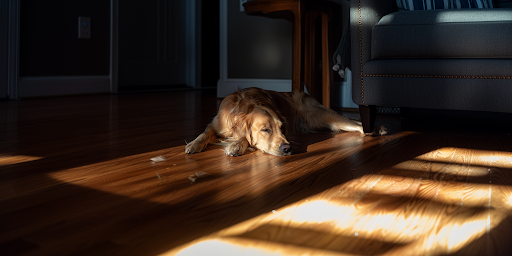
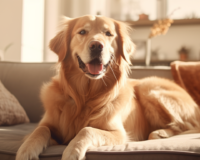
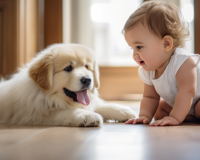
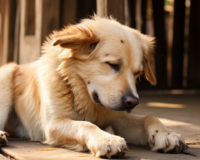
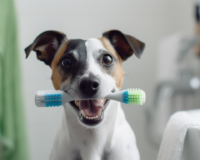
4 Comments
How often should I really bathe my dog to help with shedding? I worry about drying out their skin.
You’re right to be cautious; too frequent bathing can dry out a dog’s skin. Generally, bathing once a month is sufficient unless they get particularly dirty. Always use a dog-specific shampoo to keep their skin and coat healthy.
Can you recommend any specific brush for a Labrador Retriever?
For Labradors, who are known for their shedding, a de-shedding tool like the Furminator can be very effective. It helps remove loose hair without damaging the coat. Regular use can really cut down on shedding.